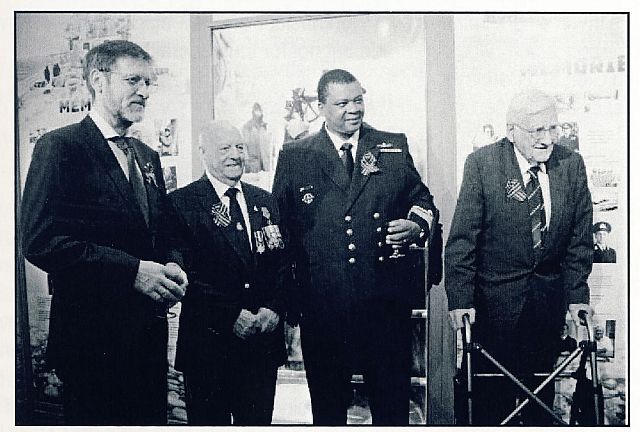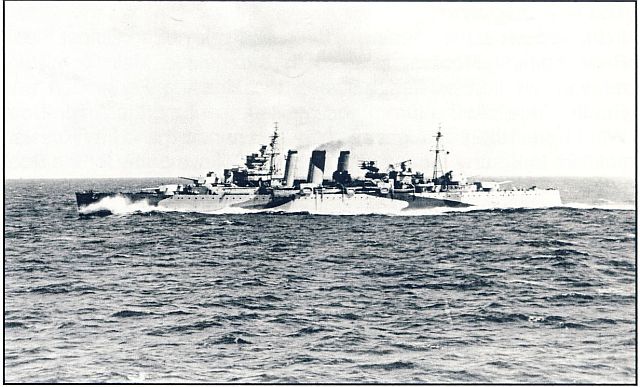

 The South African
The South African
War-time British Prime Minister, Winston Churchill, described the Arctic convoys as 'the worst journey in the world'.
On Friday, 13 May 2016, the South African Naval Museum, in cooperation with the Embassy of the Russian Federation in South Africa, opened its new display entitled 'RUSSIAN ARCTIC CONVOYS 1941-1945'. Its purpose is to honour those South Africans that served on these daring voyages in their pursuit to assist the besieged Soviet Union during the Second World War.

The opening of the display was officiated by the Ambassador of the Russian Federation in South Africa, Mr Mikhail Petrakov and the SA Navy's Flag Officer Fleet, Rear Admiral B K Mhlana. Two of the last surviving Second World War veterans of the Arctic Convoys in the Cape Town area attended the opening. Mr Joseph Wilkinson (89), from Milnerton, served on the Tribal-class destroyer, HMS Ashanti, while Mr Peter Gordon Poland (92), from Constantia, served on the M-class destroyer HMS Matchless. Reflecting on the Arctic Convoys, Mr Gordon Poland remembered: 'From January 1943 I served as navigator of the destroyer Matchless. Our main task from November until April 1943 was to escort a convoy, PQ-17, to the Russian port of Murmansk. The Germans had taken measures to attack the convoy by basing a large force of surface vessels, U-Boats and Luftwaffe near North Norway. It was very cold and very dangerous, with frequent attacks of the U-boats and Luftwaffe'.
The Russian Arctic Convoys of the Second World War were oceangoing convoys from the United Kingdom to northern ports of Arkhangelsk and Murmansk in the Soviet Union. Their purpose was to provide much needed supplies in response to the invasion of the Soviet Union by Nazi Germany. Between 1941 and 1945 there were 78 convoys, in which 1 400 merchant ships delivered essential supplies to the Soviet Union under the Lend-Lease program. Escorted by ships of the Royal Navy, in which no less than 250 South Africans served, eighty-five merchant vessels and 16 Royal Navy warships were lost. Nazi Germany's Kriegsmarine lost a number of vessels, including one battleship, three destroyers and at least 30 U-boats. The wintry Arctic conditions were atrocious and for the slow merchant supply vessels, the passage was even worse, thanks to prowling U-boats and threats posed from the air by the German Luftwaffe.
South Africans and the Arctic Convoys
Although it is not known precisely how many South Africans served in the Russian Convoys, there were no less than 250 of them that served on Royal Navy warships. One hundred and fifty men served in the cruiser HMS Shropshire which sailed in the first Russian Convoy codenamed 'DERVISH'. In one of the most significant Royal Navy losses, that of the light cruiser HMS Edinburgh on 30 April 1942, two South Africans were killed. They were Able Seamen W H van Dordrecht and V W Drummond.

HMS Shrophsire
(Photo: S A Naval Museum)
In addition to the seconded South Africans who had joined the Royal Naval Volunteer Reserve in South Africa and were on loan to the Royal Navy, a number of South Africans were already serving in the Royal Navy or Royal Naval Reserve. Out of 10 332 officers and ratings serving in the South African Naval Forces, 2 937 were seconded to the Royal Navy. South African Navy losses during the war amounted to 338.
Russian commemorations
The Russian Federation and its community have always held the actions of the sailors of the Arctic Convoys in high esteem. As recently as 2015 a commemorative medal was awarded to those surviving veterans who had participated in the convoys. The Jubilee Medal '70 Years of Victory in the Great Patriotic War 1941-1945' was established on 21 December 2013 by Presidential Decree to denote the 70th anniversary of the 1945 victory over Nazi Germany. It was preceded by the 50 Year Jubilee Medal (awarded in 1995), 60 Year Jubilee Medal (awarded in 2000) and 65 Year Jubilee Medal (awarded in 2005).
The new display
In his speech at the opening of the new display, Flag Officer Fleet, Rear Admiral Mhlana, referred to the unique historic militaryrelationship that existed between the Russian Federation and South Africa. At the turn of the previous century, the Anglo-Boer War (1899-1902), brought an estimated hundred and fifty Russian soldiers to South Africa to fight a war, out of sympathy for the Boer cause. During the apartheid era, the USSR was one of the key supporters of the struggle for liberation and the ANC's armed wing, Umkhonto we Sizwe received military aid for more than forty years. Many serving South African Navy flag officers received their military training in the former USSR. Admiral Mhlana mentioned that bilateral relations between the Russian Federation and South Africa have been strengthened in recent years, stating that the cooperation shown between the Ambassador of the Russian Federation and the SA Naval Museum, to mount this new display, was a continuation and affirmation of such relations.
The South African Naval Museum in Simon's Town is open seven days a week from 09:30 - 15:30.
Enquiries: 021 7874622/4635.
THE ARCTIC STAR
On 26 February 2013, the British Government announced that veterans of the Arctic Convoys could begin to apply for the Arctic Star, a campaign medal. The surviving veterans would then have been in their nineties. Many had earlier refused to accept the Atlantic Star that was awarded when the war ended; they reiterated that their campaign should be recognised by a specific medal, as it was quite different from the naval war in the Atlantic. Widows and next-of-kin may apply for the Arctic Star at www.gov.uk/the-ministry-of-defence-medal-office or by writing to: The Arctic Star, MOO Medal Office, Imjin Barracks, Innsworth, Gloucester, England GL31 HW.
The late George Barrell, former Chair and committee member of the SA Military History Society, served on a destroyer based in Rosyth, Scotland, that was part of the Arctic Convoys to Archangel in Russia.
Return to Journal Index OR Society's Home page
South African Military History Society / scribe@samilitaryhistory.org